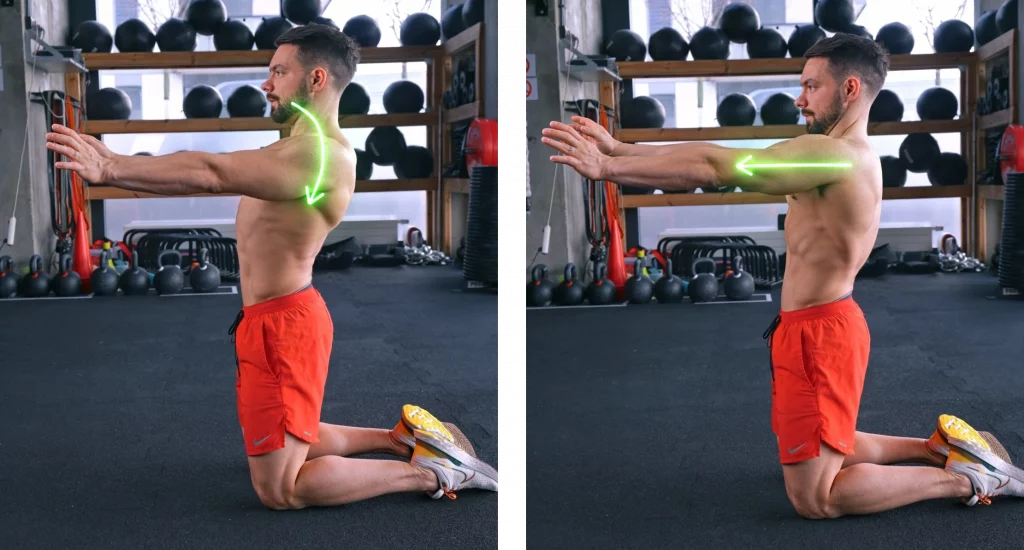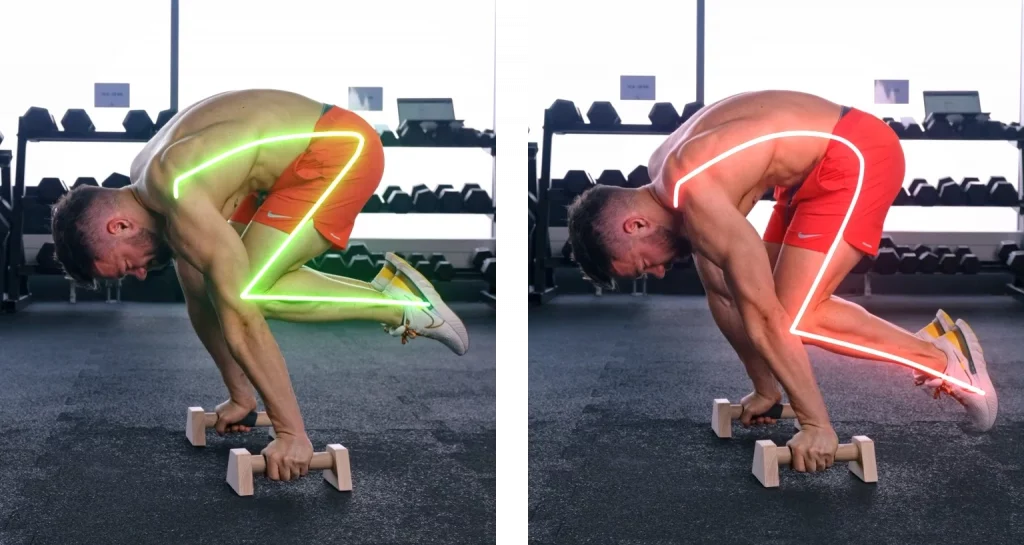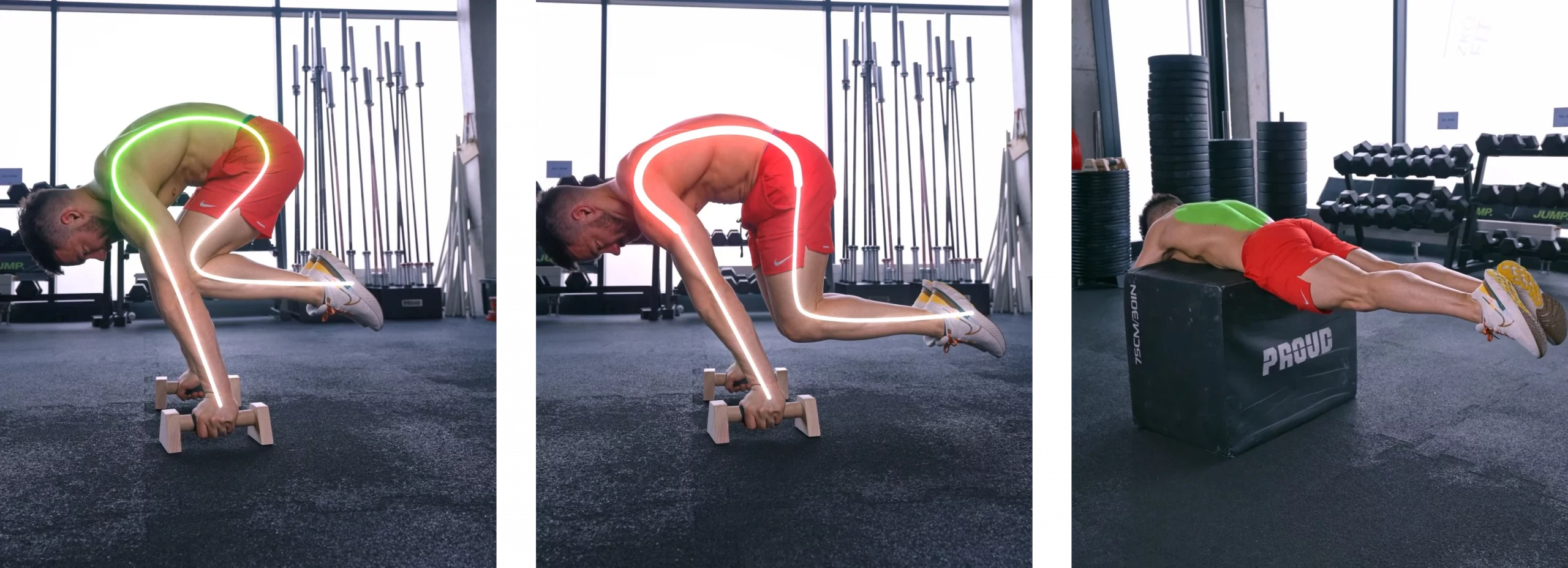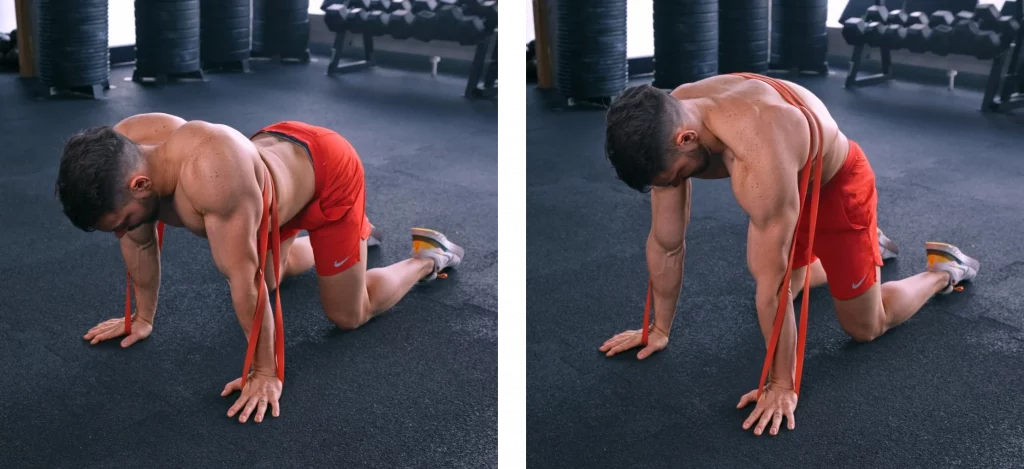what is
the tuck planche
The Tuck Planche is an advanced beginner calisthenics upper body pushing skill. The tuck planche is an essential calisthenics move for anyone planning to pursue the calisthenics journey more seriously. The goal is for the athlete to support the body vertically through the strength of the arms and shoulders with the hips and shoulders on the same height. As the name already suggests the legs should be tucked with the knees pulled towards the chest.
Straight Arm Skill
In many high level calisthenics skills such as the iron cross or full planche the athlete is required to fully locked the elbows. This places pressure on the joints and the body must be prepared over multiple years.
The tuck planche is one of the first straight arm skill and athlete will learn and it is this exact detail which makes the tuck planche such a significant and important step in your body weight fitness journey. So whilst you want to make sure to build time under tension slowly to avoid injuries you also want to assure yourself that you focus on locking out your elbows from day one.

Fully Body with Shoulder Focus
The goal of the tuck planche is to lift the hips to the height of shoulders whilst pulling knees to chest. When ever we think of planche conditioning and planche workouts we think of shoulder and arm strength. This is of course correct because all pressure travels through the arms into the floor but the rest of your body has to be strong and coordinated as well to work in perfect harmony.
How to
tuck planche
Planches work because we lean the shoulders towards the front. Picture yourself in a push up position with your feet on elevated on a bench. Keeping your hips straight walk your feet towards the front pushing the shoulders out. More and more weight will transfer from your feet into your hands until eventually you will collapse and fall on your face. Now imagine you were able to resist with your arms and you wouldn’t collapse on your face. Basically, this is a planche.
The longer the lever gets, in our case the legs, the more we have to lean. In a tuck planche the knees are pulled to the chest turning the body into a small, tight ball. We therefore only require smaller amounts of lean.
The more we extend the legs out or in other word untuck, the more we have to lean and the heavier the load gets on the shoulders.
In order to nail your first planche and to move on to more advanced progressions in the future a variety of things have to come together. You need to combine strength with coordination into technique. The only thing you do not need much in order to do a tuck planche is mobility. Yet having basic mobility will help to avoid injuries during training.
Main Focus – Shoulders
Without any doubt the main work in a tuck planche happens in the shoulders. Your anterior deltoid in combination with the chest and biceps have to work hard to resist and hold the static position.
Shoulder Protraction
This is by far the most important concept of any planche. In order to be able to use your muscles to their fullest potential and in order to truly protect them from injuries you have to protract. Protraction means pushing your shoulders towards the front. Imagine you were trying to make them kiss in front of your chest. I always like to believe that through protraction the shoulders travel forwards and in allowing me to simply lay on them. In reality, of course this is not exactly what happens but I like to think of it this way.
Protraction is not something that comes overnight. You will have to develop specific coordination and strength. Most of us even have to discover or develop upper back and shoulder mobility before any of this is possible.
Theoretically you can learn to planche without protraction. You won’t be able to push to your fullest potential and you won’t protect your body well from injuries (hint: I really don’t recommend this!!) but it is possible for the tuck planche. Later progressions won’t be possible anymore and you will find yourself having to dial the training back. So instead, invest into your shoulders now. Develop proper protraction strength and coordination from the start and set yourself up for a bright future!

Shoulder Depression
To create a slight mechanical advantage and to protect yourself from injuries it is recommended to push the shoulders down, away from the ears when training tuck planches. As discussed earlier, the longer your body gets the more your have to lean. Now by pushing the shoulders down you can change the length of your lever ever so sligthly shaving off maybe just a slight but of so valuable a bit of weight.
Shoulder flexion
This is the most obvious anatomical movement of the shoulders during the planche. Your deltoids, chest and even biceps need to push the hands towards an overhead position but remain in a static point. This honestly sounds much more scientific than it would need to be. What this really means is that your shoulders resist and that you use whatever you can find to push and keep the hips up.
Second Focus Point: Core
Here is where the tuck planche really differentiates from other, more advanced planche progressions. Whilst in higher planching levels the goal is to get a perfectly straight back in a tuck planche it is more than fair to round the back. Key here is compression.

Start in a regular upper support on parallel bars or in between 2 chairs, lean your shoulders slightly towards the front, bend the knees and pull them towards your chest you are already performing a tuck planche. The more you lean and the more you lift the knees the more your hips will raise and the closer they will become to being in line with your shoulders.
The more that you can pull your knees in or the more that you can compress the less weight you have on the opposite site and the less your shoulders have to work. You therefore make the exercise easier through technical, mechanical advantages.
Compression is also not something that is given for most of us. We have to develop coordination first tightly followed by strength.
Additional Working Parts of Tuck Planche
Coordinating the shoulders with the core is honestly enough of a challenge but if it was this simple it would almost be boring! To keep things interesting there are plenty more working points in the tuck planche. Let’s work through them from the bottom up.
The Wrists
All that pressure from the shoulders eventually travels through your wrists and into the floor. The more you lean the sharper the wrist angle gets and the more pressure is applied. I strongly recommend turning the wrists out to protect them from injuries. Additionally, you can use parallettes for more control and again, less risk for injuries.
Including some strengthening exercises for the forearms can be recommendable as well in case your wrists is very flexible.

The elbows
As discussed above the planche is a straight arm skill. This means we have to keep our elbows fully locked. Building up the tendon and joint strength to support the entire body in a leaning position will take time. It is essential that you allow your body to take the time that it needs! If you rush this chances are high you will get injured!
To make this pressure healthier on your elbows but also in order to be able to fully use your shoulders, chest and biceps you want to rotate your arms so that the pit of your elbows points towards the front.
The Biceps
Often disregarded and therefor a common source of planche related injuries. The biceps does significantly more in the planche than what one might expect. The biceps helps tremendously when resisting with the shoulders trying not to collapse during the static hold. Additionally, the biceps protect the elbows from hyperextending and is therefore essential when training planches. Incorporate preacher curls and similar biceps work from the very start into your training routines to build your biceps up from the start.
The Back
Your back connects the shoulders and the hips. You have to use your long back extender muscles to hold the hips up. Whilst it is a logical idea to include superman lifts on the stomach or reverse hypers to strengthen the back it does not make as much sense as you might think. The back muscles are almost never the limiting point of the planche. Especially in the tuck planche the back muscles do not have to work much as the knees are tucked to the chest.
The limiting point is almost always shoulder strength!

The knees
Last but not least we get to the knee joint. You have to fully bend them. Engage your hamstrings and pull your heels towards your glutes. Do not let your feet hang down. The floor is lava!
how to train for
the tuck planche
Learning something new is never easy. The road to the tuck planche is long and not an easy one. Long term planning and a decent understanding of the skill are essential in order to succeed.
Just like with all bodyweight skills consistency will pay off the most here. Only by creating a plan and sticking to it will you be able to monitor progress and adjust your workload. You can not increase or decrease training intensity if you don’t know how much you are actually doing.
A complete Tuck Planche Workout
Let’s start by analyzing what precisely an athlete needs to train in order to succeed with their tuck planche. Everyone’s starting point is different. We are all on our own, unique journey. By understanding what exactly needs to be trained you will be able to make your own judgment decisions on how much of each component you actually need. You might already be advanced with protraction strength but your anterior deltoids are missing force or maybe you are very strong in your shoulders but your wrists are not used to the pressure. Whilst everyone’s workout should be of similar structure progressions and volume can and should vary from athlete to athlete quite a bit.
-General and Specific Warm Up
At the head of every single workout. Start with 8-12min of low impact cardiovascular activity. This could be jogging, rope skipping, playing ball. You decide. Make it fun and break a light sweat.
Follow this with injury prevention shoulder, elbows and wrist warm up drills. These are mandatory for everyone. Do not ever skip your warm up!
-Protraction Coordination Warm Up
Even if your protraction is already killer I strongly recommend to start every workout with a few low intensity protraction drills like for example the banded cat and cow exercise or kneeling protraction push ups against the elastic. This will prime your mind muscle connection and help warm you up even more.

-Your hardest progression / Static Holds
You are warm, you’re fired up and you throughout this workout you will never again have as much energy as you have right now! The tuck planche might require technique and coordination but most of all the tuck planche is a strength skill and you want to make sure you treat it as this. Start your actual workout with your hardest progression. Since our goal at the moment is the tuck planche hold you would want to do your static hold here.
Keep in mind that this doesn’t have to be a tuck planche hold. This can be a single leg tuck planche hold, a tuck planche lean with both feet on the floor or even “just” a push up lean. You decide your level. You decide what is hardest for you and as long as your form is decent you will make progress.
-Rep based/dynamic Exercises
You can learn to tuck planche but doing exclusively holds and leans. You can keep it this simple but it will be boring. Including movement based exercises like for example deltoid raises or L sit to tuck planche lifts will have 2 major advantages.
The main problem is that noticeable progress will be VERY slow if you just train holds. If you don’t progress you will not have fun and simply burn out. If you want to learn to planche you are in it for the long game. By using lots of small baby step progressions you can get a win almost every workout or at least one time per week to keep the fire going!
Training dynamic progressions will also allow you to build functional strength not just in the exact position of the planche but also in the angles around it. This will later allow you to incorporate your planche into handstand, yoga or gymnastic sequences.
-Bent Arm Work
A great way to further advance your planche strength and to build extra protraction and lock out strength is through bent arm work such as pseudo planche push ups or walking lean push ups.
The Tuck Bent Arm Planche itself is not just a cool skill but also a great beginner friendly way of training planches. WIth bent arms your body is closer to the hands and with that your levers are shorter. Remember shorter levers means less weight and with that less strength is needed!
-Core Work
Whilst the above described approach works for pretty much all levels of planches this last section is tuck planche specific. You need to pull your knees towards your chest. So let’s train that.
L Sits, hanging leg raises and sitting leg lifts are all great options here.
-Cool Down
Don’t forget your post workout stretches. Only a healthy body can train consistently, grow and get stronger! I know you are tired at this point as it’s been a long day but kick yourself in the butt and finish strong!

Fitting Tuck Planches into your Weekly Routine
When it comes to workout scheduling you basically have 2 approaches here. You can either do tuck planche specific workouts as described above or break them apart and mix them into your weekly routine.
Generally speaking it is pretty easy and straightforward to simply work your planches on your upper body push day or on your handstand strength day.
You want to make sure your that you get adequate time to recover. This is not just to protect your body from injuries but also to make sure you can keep training intensity high and actually make gains. The goal is not to get sore from your planche training but the goal should be to do at least 1 sec or 1 measurable bit more every week in this first highest difficulty exercise.
Ideally, you will train your tuck planche twice per week. If you have the time and recovery capabilities you can also train your tuck planche 3 times per week. Some athletes also see decent results with 1 workout per week. The exact workout plan should be build around your goals, schedule and general fitness level.
Periodization & Plateau breaking
The above described workout focuses on building strength whilst improving tuck planche form, coordination and technique. Over time this has proven as highly efficient and most athletes can by slowly over time increasing difficulty make it to their goals without getting stuck.
If you do hit a plateau a change of approach can be an idea. A good approach is to take a step back from planche training for 8-12 weeks and to focus on building raw strength specifically where needed in the shoulders. You would most likely reduce training frequency to twice per week and drive up intensity. You can still keep your hardest or a hard planche progression as an optional choice at the beginning of your session but your main focus would be either on Handstand Push Ups or Military Presses and dip or eventually even weighted dips.
Training with Bands
Hanging a band overhead to support your hips is a great approach when trying to build static hold specific strength. The problem with planches is that you can only train your shoulders in the exact angle that you need by engaging them in this precise angle.
If you are trying to learn to planche you can not hold that precise angle yet and therefore not target the shoulders 100% efficiently for your goal progression. This is where bands come in handy. By using the band you can place your body in the tuck planche with the band carrying the for example 20% of your body weight that you are not strong enough yet to hold. You can then either adjust the distance between your hands and attachment point or use a weaker band over time to reduce the bands pulling power and to get closer to holding the planche by yourself.
When using a band you want to make sure that if set up allows it the band is around your hips and not your ankles. Keep in mind that placing the band around your ankles is still better than not training at all! The band should also not pull in an angle but lift your hips straight up. Picture the band as a way of cancelling out gravity to a certain degree.
Generally, when programming planche workouts I do not add elastic assisted holds into the regular workouts. Just like a cycle of strength focused work I like to keep these elastic assisted holds as a “buffer” in case a client gets stuck and needs some extra help. Especially for beginners I like to keep exercises as raw and as close to the real thing as possible to help the athlete develop a strong feeling for their own body.
Benefits & Risks
of training tuck planches
Just like with anything in life there are pro’s and con’s. When trying to figure out if learning to tuck planche is right for you it simply comes down to exploring your reasons and being honest with yourself.
Pro’s & Benefits
-cool and impressive move that showcases body control and strength
-the made gains can be applied to other aspects in your training
-great way to increase upper body pushing strength with bodyweight only exercises
-strengthens elbows tendons and joints in preparation for future goals
-can be a motivator for general fitness, diet adjustments and health gains
-provides a clear goal to work towards to and will provide you with a feeling of satisfaction
Con’s & Risks of training tuck planches
-with pressure comes risk of injuries. Especially the wrists, elbows and shoulders are at high risk here
-plateaus can leave you frustrated and discouraged
-not the most efficient exercise for pure strength gains
-gians made are highly addictive (proceed with caution)
So yes. Learning to tuck planche is a big project. But aren’t we alive for big projects?! Embarking onto the journey of tuck planches can be a wild ride. Through analyzation, some self studying and planning this winding road full of potholes can become quite a bit straighter and more even.
At the end of the day it is all about staying consistent.
Consistent training will lead to consistent results.
You can only be consistent if you stay healthy and injury free.
Always but health first. and get to work!






